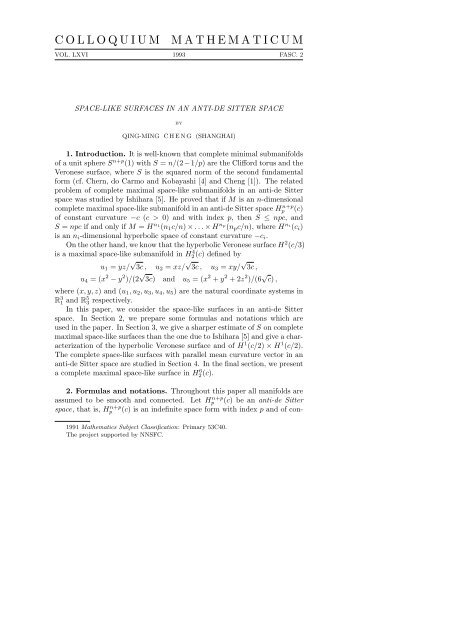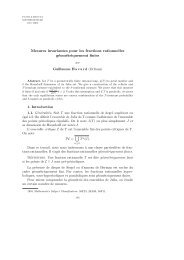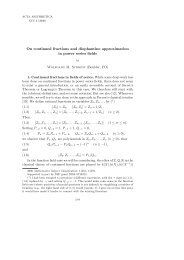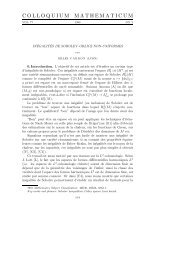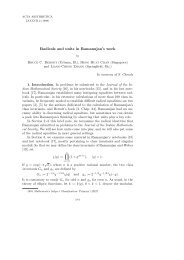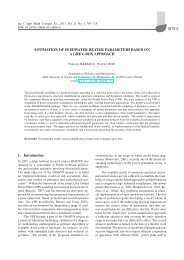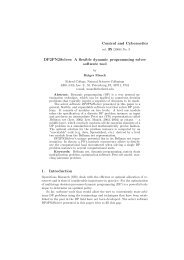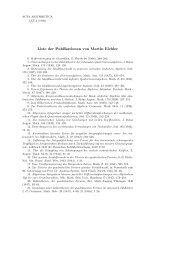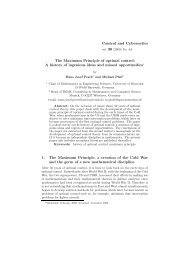SPACE-LIKE SURFACES IN AN ANTI-DE SITTER SPACE
SPACE-LIKE SURFACES IN AN ANTI-DE SITTER SPACE
SPACE-LIKE SURFACES IN AN ANTI-DE SITTER SPACE
You also want an ePaper? Increase the reach of your titles
YUMPU automatically turns print PDFs into web optimized ePapers that Google loves.
C O L L O Q U I U M M A T H E M A T I C U M<br />
VOL. LXVI 1993 FASC. 2<br />
<strong>SPACE</strong>-<strong>LIKE</strong> <strong>SURFACES</strong> <strong>IN</strong> <strong>AN</strong> <strong>AN</strong>TI-<strong>DE</strong> <strong>SITTER</strong> <strong>SPACE</strong><br />
BY<br />
Q<strong>IN</strong>G-M<strong>IN</strong>G C H E N G (SH<strong>AN</strong>GHAI)<br />
1. Introduction. It is well-known that complete minimal submanifolds<br />
of a unit sphere Sn+p (1) with S = n/(2−1/p) are the Clifford torus and the<br />
Veronese surface, where S is the squared norm of the second fundamental<br />
form (cf. Chern, do Carmo and Kobayashi [4] and Cheng [1]). The related<br />
problem of complete maximal space-like submanifolds in an anti-de Sitter<br />
space was studied by Ishihara [5]. He proved that if M is an n-dimensional<br />
complete maximal space-like submanifold in an anti-de Sitter space Hn+p p (c)<br />
of constant curvature −c (c > 0) and with index p, then S ≤ npc, and<br />
S = npc if and only if M = Hn1 (n1c/n) × . . . × Hnp (npc/n), where Hni (ci)<br />
is an ni-dimensional hyperbolic space of constant curvature −ci.<br />
On the other hand, we know that the hyperbolic Veronese surface H2 (c/3)<br />
is a maximal space-like submanifold in H4 2 (c) defined by<br />
u1 = yz/ √ 3c , u2 = xz/ √ 3c , u3 = xy/ √ 3c ,<br />
u4 = (x 2 − y 2 )/(2 √ 3c) and u5 = (x 2 + y 2 + 2z 2 )/(6 √ c) ,<br />
where (x, y, z) and (u1, u2, u3, u4, u5) are the natural coordinate systems in<br />
R 3 1 and R 5 3 respectively.<br />
In this paper, we consider the space-like surfaces in an anti-de Sitter<br />
space. In Section 2, we prepare some formulas and notations which are<br />
used in the paper. In Section 3, we give a sharper estimate of S on complete<br />
maximal space-like surfaces than the one due to Ishihara [5] and give a characterization<br />
of the hyperbolic Veronese surface and of H 1 (c/2) × H 1 (c/2).<br />
The complete space-like surfaces with parallel mean curvature vector in an<br />
anti-de Sitter space are studied in Section 4. In the final section, we present<br />
a complete maximal space-like surface in H 6 2 (c).<br />
2. Formulas and notations. Throughout this paper all manifolds are<br />
(c) be an anti-de Sitter<br />
(c) is an indefinite space form with index p and of con-<br />
assumed to be smooth and connected. Let Hn+p p<br />
space, that is, Hn+p p<br />
1991 Mathematics Subject Classification: Primary 53C40.<br />
The project supported by NNSFC.
202 Q. M. C H E N G<br />
stant curvature −c (c > 0). An n-dimensional submanifold M of Hn+p p (c)<br />
is said to be space-like if the metric induced on M from the ambient space<br />
Hn+p p (c) is positive definite. We choose a local field of orthonormal frames<br />
e1, . . . , en, en+1, . . . , en+p adapted to the indefinite Riemannian metric in<br />
Hn+p p (c) such that e1, . . . , en are tangent to M. Let ω1, . . . , ωn be a field of<br />
dual frames on M. The second fundamental form of M is given by<br />
(2.1) a = − h a ijωiωjea ,<br />
where h a ij = ha ji for any a = n + 1, . . . , n + p. The mean curvature vector h<br />
and the mean curvature H of M are defined by<br />
<br />
(2.2)<br />
h = − n<br />
and<br />
(2.3) H =<br />
i<br />
<br />
i<br />
h a ii<br />
h a ii<br />
ea<br />
2<br />
n .<br />
If H = 0, we call M maximal. The Gaussian equations of M are<br />
(2.4) Rijkl = −c(δilδjk − δikδjl) − (h a ilh a jk − h a ikh a jl) ,<br />
(2.5) Rabij = − (h a ikh b kj − h b ikh a jl) .<br />
The covariant derivative ∇a of the second fundamental form a of M has<br />
components ha ijk given by<br />
<br />
a<br />
hijkωk = dh a ij + h a kjωik + h a ikωjk + h b ijωba .<br />
Thus we can get the Codazzi equation<br />
h a ijk = h a ikj .<br />
3. Maximal space-like surfaces<br />
Theorem 1. Let M be a complete maximal space-like surface in an antide<br />
Sitter space H2+p p (c). Then S ≤ 2c, and S = 2c if and only if M =<br />
H1 (c/2) × H1 (c/2) and p = 1.<br />
R e m a r k 1. The estimate S ≤ 2c in Theorem 1 is sharper than S ≤ 2pc<br />
which has been obtained by Ishihara [5]. Our result does not depend on p.<br />
P r o o f o f T h e o r e m 1. From the Gaussian equations (2.4) and (2.5),<br />
we can get, making use of the same computations as in Ishihara [5],<br />
(3.1) (1/2)∆S = (h a ijk) 2 − ncS + N(HaHb − HbHa) + (Sa) 2 ,<br />
where Sa = (h a ij )2 , Ha = (h a ij ) and N(A) = tr(At A).
We consider the linear map<br />
<strong>SPACE</strong>-<strong>LIKE</strong> <strong>SURFACES</strong> 203<br />
(3.2) B : T ⊥ M → T M ⊗ T M , B(ea) = h a ijei ⊗ ej ,<br />
where T ⊥M and T M are the normal bundle and the tangent bundle to M<br />
respectively, and e1 and e2 are tangent to M. For any x in M, since e1 ⊗ e2,<br />
e1 ⊗ e1 and e2 ⊗ e2 are a basis of TxM ⊗ TxM and ha ii = 0, we have<br />
(3.3) B(ea) = 2h a 12e1 ⊗ e2 + h a 11(e1 ⊗ e1 − e2 ⊗ e2) for a ≥ 3 .<br />
Hence the rank of B is not greater than 2. Thus we can choose e5, . . . , e2+p<br />
such that B(ea) = 0 for a ≥ 5. From (3.3) we have ha ij = 0 for a ≥ 5. Let<br />
Sab = ha ijhbij . We can take e3 and e4 such that (Sab) is diagonal. Thus<br />
<br />
3<br />
hijh 4 ij = 0 .<br />
On the other hand, we choose e1 and e2 such that h 3 ij = λiδij. Hence we<br />
can take e1, . . . , e2+p such that<br />
H3 = (h<br />
(3.4)<br />
3 <br />
λ 0<br />
ij) =<br />
0 −λ<br />
<br />
0 0<br />
Ha =<br />
0 0<br />
From (3.4), we have<br />
(3.5)<br />
(3.6)<br />
Now (3.1), (3.5) and (3.6) yield<br />
(3.7)<br />
, H4 = (h 4 ij) =<br />
for a ≥ 5 .<br />
N(HaHb − HbHa) = 16λ 2 µ 2 ,<br />
(Sa) 2 = 4(λ 4 + µ 4 ) .<br />
<br />
0 µ<br />
,<br />
µ 0<br />
(1/2)∆S = (h a ijk) 2 − 2cS + 4(λ 4 + µ 4 ) + 16λ 2 µ 2<br />
= (h a ijk) 2 + (S − 2c)S + 8λ 2 µ 2<br />
= (h a ijk) 2 + S(3S/2 − 2c) − 2(λ 2 − µ 2 ) 2 .<br />
From the result due to Ishihara [5], we know that S ≤ 2pc. According to<br />
the Gaussian equation (2.4), we see that the Ricci curvature is bounded<br />
from below. Hence from (3.7) and the generalized maximum principle given<br />
below, due to Omori and Yau, we obtain<br />
Hence S ≤ 2c.<br />
0 ≥ sup S(sup S − 2c) .<br />
Generalized maximum principle (cf. Omori [6] and Yau [7]). Let M<br />
be a complete Riemannian manifold whose Ricci curvature is bounded from
204 Q. M. C H E N G<br />
below. Let F be a C 2 -function bounded from above on M. Then there exists<br />
a sequence {p m } of points in M such that<br />
lim F (p m ) = sup F , lim ∇F (p m ) = 0 and lim sup ∆F (p m ) ≤ 0 .<br />
If S = 2c, from Theorem 3 in [5], we have M = H 1 (c/2) × H 1 (c/2).<br />
Thus we complete the proof of Theorem 1.<br />
Corollary 1. The Gaussian curvature of the complete maximal space-<br />
(c) is nonpositive.<br />
like surface in an anti-de Sitter space H 2+p<br />
p<br />
P r o o f. From the Gaussian equation (2.4), we have<br />
(3.8) K = −c + S/2<br />
where K is the Gaussian curvature. Theorem 1 implies K ≤ 0.<br />
In particular, when p = 1, we have<br />
Theorem 2. Let M be a complete maximal space-like surface in an antide<br />
Sitter space H 3 1 (c) with inf K > −c. Then K = 0 and M = H 1 (c/2)<br />
× H 1 (c/2).<br />
P r o o f. Since the codimension of M is one, from (3.1) we have<br />
(3.9) (1/2)∆S = (hijk) 2 + S(S − 2c) .<br />
We choose e1 and e2 such that hij = λiδij. Because M is maximal, we get<br />
hii = 0. Hence (hiik) = 0 for any k. Now,<br />
|∇S| 2 = 4 hijhijk<br />
2<br />
= 4 λihiik<br />
= 4 (λ1h11k + λ2h22k) 2 = 4(λ1 − λ2) 2 (h11k) 2<br />
= 2(λ1 − λ2) 2 (hiik) 2 = 4S (hiik) 2 .<br />
Moreover,<br />
(hijk) 2 = 3 <br />
(hiik) 2 + (hkkk) 2 = 2 (hiik) 2 .<br />
Hence<br />
i=k<br />
(3.10) 2S (hijk) 2 = |∇S| 2 .<br />
From (3.9) and (3.10), we have<br />
(3.11) S∆S = |∇S| 2 + 2S 2 (S − 2c) .<br />
Thus inf S = 0 or inf S ≥ 2c from the generalized maximum principle.<br />
According to (3.8), we get inf K = −c or inf K ≥ 0. From the assumption<br />
and Theorem 1, we obtain S = 2c and M = H 1 (c/2) × H 1 (c/2).<br />
Theorem 3. Let M be a complete maximal space-like surface in an anti-<br />
(c) (p > 1) with parallel second fundamental form. If<br />
de Sitter space H 2+p<br />
p<br />
2
<strong>SPACE</strong>-<strong>LIKE</strong> <strong>SURFACES</strong> 205<br />
S ≤ 4c/3, then M = H 2 (c) is totally geodesic or M = H 2 (c/3) is the<br />
hyperbolic Veronese surface.<br />
P r o o f. Since the second fundamental form is parallel, we have (h a ijk )2<br />
= 0 and S is constant. From (3.7) we obtain<br />
S(3S/2 − 2c) − 2(λ 2 − µ 2 ) 2 = 0 .<br />
Hence λ 2 = µ 2 and S = 0 or S = 4c/3. If S = 0, M = H 2 (c) is totally<br />
geodesic. If S = 4c/3, M = H 2 (c/3) is the hyperbolic Veronese surface.<br />
Theorem 4. Let M be an n-dimensional complete maximal space-like<br />
hypersurface in an anti-de Sitter space H n+1<br />
1 (c) with parallel second fundamental<br />
form. Then M is Hn (c) or Hn1 (n1c/n) × Hn−n1 [(n − n1)c/n].<br />
P r o o f. Since M is a hypersurface, from (3.1) we have<br />
(1/2)∆S = (hijk) 2 + S(S − nc) .<br />
By the same proof as for Theorem 3, we get S = 0 or S = nc. From the<br />
result due to Ishihara [5], we know that Theorem 4 is true.<br />
Corollary 2. Let M be a complete isoparametric maximal space-like<br />
hypersurface in an anti-de Sitter space H n+1<br />
1 (c). Then M = Hn (c) or<br />
Hn1 (n1c/n) × Hn−n1 [(n − n1)c/n] (n > n1 ≥ 1).<br />
P r o o f. Since M is isoparametric, we know that the second fundamental<br />
form of M is parallel. From Theorem 4, we conclude that Corollary 2 is true.<br />
4. Space-like surfaces with parallel mean curvature vector<br />
Theorem 5. Let M be a complete space-like surface with parallel mean<br />
curvature vector in an anti-de Sitter space H 2+p<br />
2 (c). Then S ≤ 2c + 4H2 if<br />
p = 1, S ≤ (8/3)c + (14/3)H2 if p = 2 and S ≤ 2(p − 1)c + 2pH2 if p > 2.<br />
P r o o f. If the mean curvature H is zero, then from Theorem 1, we have<br />
S ≤ 2c. Hence, next we suppose H = 0. We choose e3 such that h = He3.<br />
Then we have<br />
(4.1) HaH3 = H3Ha for any a ≥ 3 (cf. Cheng [2]) ,<br />
(4.2) tr H3 = 2H , tr Ha = 0 for a > 3 .<br />
By setting µij = h 3 ij − Hδij and τ a ij = ha ij<br />
for a > 3, we have<br />
|µ| 2 = (µij) 2 = (h 3 ij) 2 − 2H 2 ,<br />
|τ| 2 = (τ a ij) 2 = (h a ij) 2 ,<br />
(4.3) S = |µ| 2 + |τ| 2 + 2H 2 .<br />
It can be seen that |µ| 2 and |τ| 2 are independent of the choice of the frame<br />
fields and are functions globally defined on M. Making use of the similar
206 Q. M. C H E N G<br />
proof as in Cheng [2], we get<br />
(4.4)<br />
(1/2)∆|µ| 2 = (h 3 ijk) 2 − 2c (h 3 ij) 2 + 4cH 2 − 2H tr(H3) 3<br />
+ tr(H3Ha) 2 + [tr(H3) 2 ] 2 .<br />
For a fixed index a, since HaH3 = H3Ha, we can choose e1 and e2 such that<br />
h a ij = λa i δij and h 3 ij = λiδij. Hence tr(H3Ha) 2 = (1/2)(|µ| 2 + 2H 2 ) tr(Ha) 2 ,<br />
which does not depend on the choice of frame fields. Thus<br />
tr(H3Ha) 2 = (1/2)(|µ| 2 + 2H 2 )|τ| 2 .<br />
We choose e1 and e2 such that h 3 ij = λiδij. We know<br />
(4.5) λ1 + λ2 = 2H ,<br />
(4.6) 2H tr(H3) 3 = 2H((λ1) 3 + (λ2) 3 )<br />
Hence from (4.4) and (4.6), we obtain<br />
= 2H(λ1 + λ2)((λ1) 2 + (λ2) 2 − λ1λ2)<br />
= 6H 2 (|µ| 2 + 2H 2 ) − 8H 4 .<br />
(4.7) (1/2)∆|µ| 2 ≥ (−2c − 2H 2 + |µ| 2 )|µ| 2 + (1/2)(|µ| 2 + 2H 2 )|τ| 2 .<br />
If p = 1, making use of the same proof as in Cheng [2], we have |µ| 2 ≤<br />
2c + 2H 2 . Hence S ≤ 2c + 4H 2 .<br />
If p > 1, making use of similar calculations to [2], we have<br />
(4.8)<br />
(1/2)∆|τ| 2 ≥ − 2c|τ| 2 + |τ| 4 /(p − 1) + h a kmh 3 mkh 3 ijh a ij<br />
− 2 h 3 ikh a kmh 3 mjh a ij + h a imh 3 mkh 3 kjh a ij<br />
− 2H h a imh 3 mjh a ij + h 3 ikh 3 kmh a mjh a ij .<br />
For a fixed index a, since HaH3 = H3Ha, we choose e1 and e2 such that<br />
h a ij = λa i δij and h 3 ij = λiδij. Then we get, for fixed a,<br />
h a kmh 3 mkh 3 ijh a ij − 2 h 3 ikh a kmh 3 mjh a ij + h a imh 3 mkh 3 kjh a ij<br />
− 2H h a imh 3 mjh a ij + h 3 ikh 3 kmh a mjh a ij<br />
<br />
= λiλ a i<br />
2<br />
− 2H λi(λ a i ) 2<br />
= (λ1 − λ2) 2 (λ a 1) 2 − 4H 2 (λ a 1) 2<br />
= (|µ| 2 − 2H 2 ) tr(Ha) 2 .<br />
(by (4.2))<br />
Both sides of the equality above do not depend on the choice of frame fields.<br />
Therefore we have<br />
(4.9) h a kmh 3 mkh 3 ijh a ij − 2 h 3 ikh a kmh 3 mjh a ij + h a imh 3 mkh 3 kjh a ij
Hence, from (4.8) and (4.9), we have<br />
<strong>SPACE</strong>-<strong>LIKE</strong> <strong>SURFACES</strong> 207<br />
− 2H h a imh 3 mjh a ij + h 3 ikh 3 kmh a mjh a ij<br />
= (|µ| 2 − 2H 2 )|τ| 2 .<br />
(4.10) (1/2)∆|τ| 2 ≥ −2c|τ| 2 + |τ| 4 /(p − 1) + (|µ| 2 − 2H 2 )|τ| 2 .<br />
Now (4.7)+(4.10) implies, from (4.3),<br />
(1/2)∆(S − 2H 2 ) ≥ − (2c + 2H 2 )(S − 2H 2 ) + |µ| 4<br />
+ [1/(p − 1)]|τ| 4 + (3/2)|τ| 2 |µ| 2 + H 2 |τ| 2<br />
<br />
2 2 2 2 −(2c + 2H )(S − 2H ) + (3/4)(S − 2H ) if p = 2,<br />
≥<br />
−(2c + 2H2 )(S − 2H2 ) + (S − 2H2 ) 2 /(p − 1) if p > 2.<br />
Making use of a similar proof to [2], we have<br />
<br />
2 (8/3)c + (14/3)H if p = 2,<br />
S ≤<br />
2(p − 1)c + 2pH2 if p > 2.<br />
R e m a r k 2. When p = 1, the hyperbolic cylinder satisfies S = 2c+4H 2 .<br />
Hence the estimate in Theorem 5 is optimal, which has been obtained by<br />
the author and Nakagawa [3] if p = 1.<br />
5. An example of a complete maximal space-like surface in<br />
H 6 2 (c). We consider the space-like immersion of H 2 (c/2) into H 6 2 (c) defined<br />
by<br />
u1 = [1/(24 √ c)]x(x 2 + y 2 + 4z 2 ) , u5 = ( 10/c/12)xyz ,<br />
u2 = [1/(24 √ c)]y(x 2 + y 2 + 4z 2 ) , u6 = ( 6/c/72)z(3x 2 + 3y 2 + 2z 2 ) ,<br />
u3 = ( 15/c/72)x(x 2 − 3y 2 ) , u7 = ( 10/c/24)z(x 2 − y 2 )/24 ,<br />
u4 = ( 15/c/72)y(3x 2 − y 2 ) ,<br />
where (x, y, z) and (u1, . . . , u7) are the natural coordinate systems in R 3 1 and<br />
R 7 3 respectively. It is obvious that H 2 (c/6) is a complete space-like surface<br />
in H 6 2 (c). We can also easily prove that H 2 (c/6) is maximal in H 6 2 (c).<br />
REFERENCES<br />
[1] Q. M. Cheng, Maximum principle in the geometry of submanifolds, thesis, Kyushu<br />
University, 1991.<br />
[2] —, Complete space-like submanifolds in de Sitter spaces with parallel mean curvature<br />
vector, Math. Z. 206 (1991), 333–339.<br />
[3] Q. M. Cheng and H. Nakagawa, Totally umbilical hypersurfaces, Hiroshima J.<br />
Math. 20 (1990), 1–10.
208 Q. M. C H E N G<br />
[4] S. S. Chern, M. do Carmo and S. Kobayashi, Minimal submanifolds of a sphere<br />
with second fundamental form of constant length, in: Functional Analysis and Related<br />
Fields, Springer, Berlin, 1970, 59–75.<br />
[5] T. Ishihara, Maximal space-like submanifolds of a pseudo-Riemannian space of<br />
constant curvature, Michigan Math. J. 35 (1988), 345–352.<br />
[6] H. Omori, Isometric immersions of Riemannian manifolds, J. Math. Soc. Japan 19<br />
(1967), 205–214.<br />
[7] S. T. Yau, Harmonic functions on complete Riemannian manifolds, Comm. Pure<br />
Appl. Math. 28 (1975), 201–228.<br />
<strong>IN</strong>STITUTE OF MATHEMATICS<br />
FUD<strong>AN</strong> UNIVERSITY<br />
SH<strong>AN</strong>GHAI 200433<br />
P.R. CH<strong>IN</strong>A<br />
Reçu par la Rédaction le 21.7.1992


